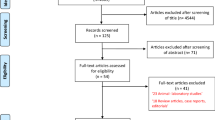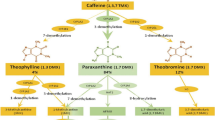Abstract
Findings regarding the association between tea and coffee consumption and oxalate-calcium stone are sparse and uncertain. The purpose of this study was to investigate the relations of tea and coffee with the risk of calcium oxalate stone formation. A total sample of 215 newly diagnosed patients with calcium oxalate stones and 215 controls matched for sex and age were recruited. Dietary intake of participants was assessed using a validated food frequency questionnaire over the preceding year and participants were asked to determine how many glasses of tea and cups of coffee they usually use. The associations between tea and coffee and kidney stone were examined using multivariable logistic regression. Compared with controls, cases had greater intake of tea (2.18±0.76 vs. 1.82±0.79 glasses/d) but lower intake of coffee (1.18±0.38 vs. 1.26±0.44 cups/week). After adjustment for potential confounders, compared with those who drank <2 glasses of tea/d, individuals with tea consumption of ≥4 glasses/d had greater risk for having calcium oxalate stone (OR= 2.73; 95 % CI: 1.50, 4.99). In the crude model, compared with coffee consumption for <1 cup/week, consumption of ≥1 cup/week was associated with a 38 % decrease in the risk of calcium oxalate stone. However, adjustment for potential confounders disappeared the significance (OR=0.81; 95 % CI: 0.48, 1.35). These results suggest that while high consumption of tea is associated with increased risk of calcium oxalate kidney stone, coffee drinking is not pertinent. However, due to low consumption of coffee in this population, our results should be interpreted cautiously.
Similar content being viewed by others
Data Availability
The datasets analyzed during the current study are available from the corresponding author on reasonable request.
Code Availability
Not Applicable.
Abbreviations
- ANCOVA:
-
“Analysis of covariance” is a general linear model which evaluates whether the means of a dependent variable are equal across levels of a categorical independent variable while statistically controlling for the effects of other continuous variables
- ANOVA:
-
“Analysis of variance” is a collection of statistical models and their associated estimation procedures used to analyze the differences among means
- BMI:
-
“Body mass index” is defined as the body mass divided by the square of the body height and is intended to quantify tissue mass
- FFQ:
-
“Food frequency questionnaire” is a dietary assessment tool delivered as a questionnaire to estimate frequency and portion size information about food and beverage consumption over a specified period of time
- IPAQ:
-
“International physical activity questionnaire” is a 27-item self-reported measure of physical activity
- Met:
-
“Metabolic equivalent of task” is the objective measure of the ratio of the rate at which a person expends energy
References
Moe OW (2006) Kidney stones: pathophysiology and medical management. Lancet 367:333–344. https://doi.org/10.1016/S0140-6736(06)68071-9
Bangash K, Shigri F, Jamal A, Anwar K (2011) Spectrum of renal stones composition; chemical analysis of renal stones. Int J Pathol 9:63–66. https://doi.org/10.4103/iju.IJU_363_16
Baumann JM (1998) Stone prevention: why so little progress? Urol Res 26:77–81. https://doi.org/10.1007/s002400050027
Kim HH, Kwak C, Jeong BC, Kim SW (2002) Effect of oxalate on the growth of renal tubular epithelial cells. J Endourol 16:261–4. https://doi.org/10.1089/089277902753752250
Hackett RL, Shevock PN, Khan SR (1994) Madin-Darby canine kidney cells are injured by exposure to oxalate and to calcium oxalate crystals. Urol Res 22:197–203. https://doi.org/10.1007/BF00541892
Charrier MJ, Savage GP, Vanhanen L (2002) Oxalate content and calcium binding capacity of tea and herbal teas. Asia Pac J Clin Nutr 11:298–301. https://doi.org/10.1046/j.1440-6047.2002.00294.x
Hönow R, Gu KL, Hesse A, Siener R (2010) Oxalate content of green tea of different origin, quality, preparation and time of harvest. Urol Res 38:377–381. https://doi.org/10.1007/s00240-009-0245-x
Chen HY, Wu JS, Chang YF et al (2019) Increased amount and duration of tea consumption may be associated with decreased risk of renal stone disease. World J Urol 37:379–384. https://doi.org/10.1007/s00345-018-2394-4
Ferraro PM, Taylor EN, Gambaro G, Curhan GC (2013) Soda and other beverages and the risk of kidney stones. Clin J Am Soc Nephrol 8:1389–1395. https://doi.org/10.2215/CJN.11661112
Goldfarb DS, Fischer ME, Keich Y, Goldberg J (2005) A twin study of genetic and dietary influences on nephrolithiasis: a report from the Vietnam Era Twin (VET) Registry. Kidney Int 67:1053–1061. https://doi.org/10.1111/j.1523-1755.2005.00170.x
Curhan GC, Willett WC, Speizer FE, Stampfer MJ (1998) Beverage use and risk for kidney stones in women. Ann Intern Med 128:534–540. https://doi.org/10.7326/0003-4819-128-7-199804010-00003
Dai M, Zhao A, Liu A et al (2013) Dietary factors and risk of kidney stone: a case-control study in southern China. J Ren Nutr 23:e21–e28. https://doi.org/10.1053/j.jrn.2012.04.003
Krieger JN, Kronmal RA, Coxon V et al (1996) Dietary and behavioral risk factors for urolithiasis: potential implications for prevention. Am J Kidney Dis 28:195–201. https://doi.org/10.1016/s0272-6386(96)90301-7
Wang S, Zhang Y, Mao Z et al (2014) A meta-analysis of coffee intake and risk of urolithiasis. Urol Int 93:220–228. https://doi.org/10.1159/000356559
Fung TT, Hu FB, Pereira MA et al (2002) Whole-grain intake and the risk of type 2 diabetes: a prospective study in men. Am J Clin Nutr 76:535–540. https://doi.org/10.1093/ajcn/76.3.535
Mirmiran P, Esfahani FH, Mehrabi Y et al (2010) Reliability and relative validity of an FFQ for nutrients in the Tehran lipid and glucose study. Public Health Nutr 13:654–662. https://doi.org/10.1017/S1368980009991698
Ghaffarpour M, Houshiar-Rad A, Kianfar H (1999) The manual for household measures, cooking yields factors and edible portion of foods. 7:213. Nashre Olume Keshavarzy, Tehran
Moghaddam MB, Aghdam FB, Jafarabadi MA et al (2012) The Iranian Version of International Physical Activity Questionnaire (IPAQ) in Iran: content and construct validity, factor structure, internal consistency and stability. World Appl Sci J 18:1073–1080. https://doi.org/10.5829/idosi.wasj
Wang J, Luo GT, Niu WJ et al (2013) [Risk factors for the kidney stones: a hospital-based case-control study in a distric hospital in Beijing]. Beijing Da Xue Xue Bao Yi Xue Ban 45:971–974
Xu C, Zhang C, Wang XL et al (2015) Self-fluid management in prevention of kidney stones: a PRISMA-Compliant Systematic Review and Dose-Response Meta-Analysis of observational studies. Medicine 94:e1042. https://doi.org/10.1097/MD.0000000000001042
Zhao A, Dai M, Chen YJ et al (2015) Risk factors associated with nephrolithiasis: a case-control study in China. Asia Pac J Public Health 27:NP414–NP424. https://doi.org/10.1177/1010539512445189
Ferraro PM, Taylor EN, Gambaro G, Curhan GC (2014) Caffeine intake and the risk of kidney stones. Am J Clin Nutr 100:1596–1603. https://doi.org/10.3945/ajcn.114.089987
Jeong BC, Kim BS, Kim JI, Kim HH (2006) Effects of green tea on urinary stone formation: an in vivo and in vitro study. J Endourol 20:356–361. https://doi.org/10.1089/end.2006.20.356
Del Castillo MD, Gordon MH, Ames JM (2005) Peroxyl radical-scavenging activity of coffee brews. Eur Food Res Technol 221:471–477. https://doi.org/10.1007/s00217-005-1209-1
Massey LK, Sutton RA (2004) Acute caffeine effects on urine composition and calcium kidney stone risk in calcium stone formers. J Urol 172:555–558. https://doi.org/10.1097/01.ju.0000129413.87024.5c
Głuszek J (1988) The effect of glucose intake on urine saturation with calcium oxalate, calcium phosphate, uric acid and sodium urate. Int Urol Nephrol 20(6):657–664. https://doi.org/10.1007/BF02549499
Acknowledgements
The authors would like to extend their gratitude and acknowledgements to all study participants and study team members for their time and energy spent on this project.
Funding
This work was supported by Electronic Health and Statistics Surveillance Research Center, Science and Research Branch. Islamic Azad University.
Author information
Authors and Affiliations
Contributions
FH and BA contributed to conception and analysis. BA and RS contributed to the study design and data collection. FH and RS contributed to manuscript draft. BA contributed to data interpretation and supervised the study. All authors approved the final manuscript for submission.
Corresponding author
Ethics declarations
Ethics Approval
Ethical approval (IR.IAU.SRB.REC.1398.146) was obtained from Iran National Committee for Ethics in Biomedical Research.
Consent to Participate
All patients provided written informed consent.
Consent for Publication
Patients signed informed consent regarding publishing their data.
Conflict of Interests
The authors report no conflict of interests.
Additional information
Publisher’s Note
Springer Nature remains neutral with regard to jurisdictional claims in published maps and institutional affiliations.
Rights and permissions
About this article
Cite this article
Haghighatdoost, F., Sadeghian, R. & Abbasi, B. The Associations Between Tea and Coffee Drinking and Risk of Calcium-Oxalate Renal Stones. Plant Foods Hum Nutr 76, 516–522 (2021). https://doi.org/10.1007/s11130-021-00933-4
Accepted:
Published:
Issue Date:
DOI: https://doi.org/10.1007/s11130-021-00933-4




